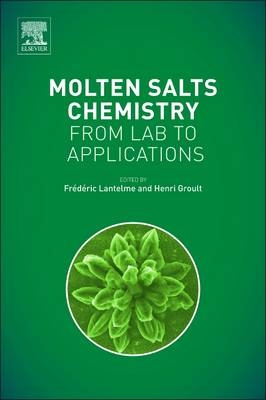
Molten Salts Chemistry
Elsevier Science Publishing Co Inc (Verlag)
978-0-12-398538-5 (ISBN)
Molten salts and fused media provide the key properties and the theory of molten salts, as well as aspects of fused salts chemistry, helping you generate new ideas and applications for fused salts.Molten Salts Chemistry: From Lab to Applications examines how the electrical and thermal properties of molten salts, and generally low vapour pressure are well adapted to high temperature chemistry, enabling fast reaction rates. It also explains how their ability to dissolve many inorganic compounds such as oxides, nitrides, carbides and other salts make molten salts ideal as solvents in electrometallurgy, metal coating, treatment of by-products and energy conversion.This book also reviews newer applications of molten salts including materials for energy storage such as carbon nano-particles for efficient super capacitors, high capacity molten salt batteries and for heat transport and storage in solar plants. In addition, owing to their high thermal stability, they are considered as ideal candidates for the development of safer nuclear reactors and for the treatment of nuclear waste, especially to separate actinides from lanthanides by electrorefining.
Henri Groult is Director of Research of CNRS-UPMC-ESPCI UMR 7612, University of Pierre and Marie Curie (Paris 6) in France. He has devoted his research life to fluorine chemistry, electrochemistry, and molten salt chemistry. His main research subjects are electrolytic production of fluorine gas, fluorine compounds for primary and secondary lithium batteries, and electrochemical properties of molten fluorides and chlorides. He has obtained interesting results on fluorine evolution reaction on carbon electrodes, discharge behavior of carbon-fluorine compounds, charge/discharge characteristics of metal fluorides, and electrochemical properties of molten salts. On these subjects, he published more than 100 papers and 7 books. His activity has played an important role in fluorine chemistry in France. He has served as Director of the French Network of Fluorine, Chairman of the 17th European Symposium on Fluorine Chemistry (Paris, July 2013), and Editorial board of J. Fluorine Chemistry.
1. Modelling of molten salts.2. Raman spectroscopy and pulsed neutron diffraction of molten salt mixtures containing rare earth trichlorides: trial approaches from fundamentals to pyrochemical reprocessing.3. In situ spectroscopy in molten fluoride salts.4. Thermodynamic calculations of molten salt reactor fuel systems.5. Ionic transport in molten salts.6. Salt bath thermal treating and nitriding.7. Catalysis in molten ionic media. 8. The ability of molten carbonate for the gas cleaning of biomass gasification.9. Inert anode development for high temperature molten salts.10. Boron-doped diamond electrode in molten chloride systems.11. NF3 production from electrolysis in molten fluorides.12. Corrosion in molten salts.13. Plasma-induced discharge electrolysis for nanoparticles production. 14. Electrolysis for recovery of actinides from molten LiCl-KCl.15. Electrochemical synthesis of novel niobium and tantalum compounds in molten salts.16. Preparation of carbonaceous materials in fused carbonates salts. Application to electrochemical storages devices.17. Molten carbonates from fuel cells to new energy devices.18. Synthesis and Li+ ion-exchange in molten salts of novel Hollandite-type Ky(Mn1-xCox)O2 zH2O nano-fiber for lithium battery electrodes.19. Hybrid molten carbonate/solid oxide direct carbon fuel cells.20. High temperature molten salts for solar power application. 21. The sodium metal halide (ZEBRA) battery: an example of inorganic molten salt electrolyte battery.22. Hydrogen storage and transportation system through lithium hydride by using molten salt technology.23. Nuclear energy based on thorium molten salt.24. Molten salts for nuclear applications.25. Lanthanides extraction processes in molten fluoride media.26. Development of pyrochemical separation processes for recovery of actinides from spent nuclear fuel in molten LiCl-KCl.
| Sprache | englisch |
|---|---|
| Maße | 152 x 229 mm |
| Gewicht | 1070 g |
| Themenwelt | Naturwissenschaften ► Chemie ► Anorganische Chemie |
| ISBN-10 | 0-12-398538-2 / 0123985382 |
| ISBN-13 | 978-0-12-398538-5 / 9780123985385 |
| Zustand | Neuware |
| Haben Sie eine Frage zum Produkt? |
aus dem Bereich


